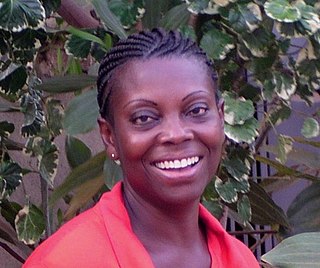Related Research Articles

Anansi or Ananse( ə-NAHN-see; literally translates to spider) is an Akan folktale character associated with stories, wisdom, knowledge, and trickery, most commonly depicted as a spider, in Akan folklore. Taking the role of a trickster, he is also one of the most important characters of West African, African American and West Indian folklore. Originating in Ghana, these spider tales were transmitted to the Caribbean by way of the transatlantic slave trade. Anansi is best known for his ability to outsmart and triumph over more powerful opponents through his use of cunning, creativity and wit. Despite taking on a trickster role, Anansi often takes centre stage in stories and is commonly portrayed as both the protagonist and antagonist.
Osei Kofi Tutu I was one of the founders of the Ashanti Empire, assisted by Okomfo Anokye, his chief priest and a distance relative from the town of Awukugua - Akuapem. The Asante comes from the Akan ethnic group of West Africa. Osei Tutu I led an alliance of Asante states against the regional hegemony, the Denkyira, completely defeating them. He ruled the Kumaseman State between c.1680/c.1695-1701 and he ruled the Ashanti Empire from late 1701-c.1717.

Onyame, Nyankopon (Onyankapon) or Odomankoma is the supreme god of the Akan people of Ghana, who is most commonly known as Anyame. The name means "The one who knows and sees everything", and "omniscient, omnipotent sky deity" in the Akan language.
The Akan people are a Kwa group living primarily in present-day Ghana and in parts of Ivory Coast and Togo in West Africa. The Akan speak dialects within the Central Tano branch of the Potou–Tano subfamily of the Niger–Congo family. Subgroups of the Akan people include: the Agona, Akuapem, Akwamu, Akyem, Anyi, Ashanti, Baoulé, Bono, Chakosi, Fante, Kwahu, Sefwi, Wassa, Ahanta and Nzema among others. The Akan subgroups all have cultural attributes in common; most notably the tracing of matrilineal descent in the inheritance of property, and for succession to high political office.
The diverse culture of Ivory Coast, a coastal West African country bordered by Ghana, Liberia, Mali, Burkina Faso, and Guinea, is exemplified by a multitude of ethnic groups, events, festivals, music, and art.

Amma Darko is a Ghanaian novelist. She had won The Golden Baobab Prize for one of her novels. She has published seven novels in total.

The Asante Empire, today commonly called the Ashanti Empire, was an Akan state that lasted from 1701 to 1901, in what is now modern-day Ghana. It expanded from the Ashanti Region to include most of Ghana as well as parts of Ivory Coast and Togo. Due to the empire's military prowess, wealth, architecture, sophisticated hierarchy and culture, the Ashanti Empire has been extensively studied and has more historic records written by European, primarily British, authors than any other indigenous culture of sub-Saharan Africa.
Bono, also known as Abron, Brong, and Bono Twi, is a Central Tano language common to the Bono people and a major dialect of the Akan dialect continuum, and thus mutually intelligible with the principal Akan dialects of Asante and Akuapem, collectively known as Twi. It is spoken by 1.2 million in Ghana, primarily in the Central Ghanaian region of Brong-Ahafo, and by over 300,000 in eastern Ivory Coast.

Religion in Ivory Coast is diverse, with no particular religion representing the majority of the population. According to the 2021 census, Islam is professed by 42.5% of the total population, while adherents of Christianity represented 39.8% of the population. In addition, 12.6% of Ivorians reported to be Irreligious and 2.2% claimed to follow Animism. Between the 2014 and 2021 censuses, the share of Christians increased from 33.9 to 39.8 percent, while the share of Muslims declined from 42.9 to 42.5 percent of the total population.

Asase Ya/Afua is the Akan goddess of fertility, love, procreation, peace, truth and the dry and lush earth in Ghana and Ivory Coast. She is also Mother of the Dead known as Mother Earth or Aberewaa.

The Asante, also known as Ashanti, are part of the Akan ethnic group and are native to the Ashanti Region of modern-day Ghana. Asantes are the last group to emerge out of the various Akan civilisations. Twi is spoken by over nine million Asante people as a first or second language.

Nyambe is the Supreme God, Sky Father, and God of the Sun across numerous traditional Bantu religions.

Akan religion comprises the traditional beliefs and religious practices of the Akan people of Ghana and eastern Ivory Coast. Akan religion is referred to as Akom. Although most Akan people have identified as Christians since the early 20th century, Akan religion remains practiced by some and is often syncretized with Christianity. The Akan have many subgroups, so the religion varies greatly by region and subgroup. Similar to other traditional religions of West and Central Africa such as West African Vodun, Yoruba religion, or Odinani, Akan cosmology consists of a senior god who generally does not interact with humans and many gods who assist humans.
Coromantee, Coromantins, Coromanti or Kormantine is an English-language term for enslaved people from the Akan ethnic group, taken from the Gold Coast region in modern-day Ghana. The term was primarily used in the Caribbean and is now considered archaic.
In the spiritual practices of the Ashanti people and Akan people, the sunsum is one's spirit. The sunsum is what connects the body (honam) to the soul (kra). The sunsum can be transmitted in a variety of ways, including from father to son during conception. This power is used to protect the carriers of this spirit. When a man dies, the sunsum returns to the metaphorical house of the father in wait to be reincarnated in the next son born of the men of that family.
The origin of death is a theme in the myths of many cultures. Death is a universal feature of human life, so stories about its origin appear to be universal in human cultures. As such it is a type of origin myth, a myth that describes the origin of some feature of the natural or social world. No one type of these myths is universal, but each region has its own characteristic types. Such myths have therefore been a frequent topic of study in the field of comparative mythology.
Juaben is a small town in the Ejisu-Juaben Municipal District, a district in the Ashanti Region of Ghana.

An Akrafena is an Ashanti sword, originally meant for warfare but also forming part of Ashanti heraldry. The foremost example of an akrafena is the Mponponsuo, which belonged to Opoku Ware II. It has survived to the present day because it is still occasionally used in ceremonies, such as the Akwasidae Festival.
Tano (Tanoɛ), whose true name is Ta Kora, but is often confused with Tano Akora, and is known as Tando to the Fante is the Abosom of war and strife in Akan mythology and Abosom of Thunder and Lightning in the Asante mythology of Ghana as well as the Agni mythology of the Ivory Coast. He represents the Tano River, which is located in Ghana. He is regarded as the highest atano, or Tano abosom in Akan mythology.
Dog, and His Human Speech is a Central African folktale collected by missionary Robert Hamill Nassau, from the Tanga people. According to scholars, the tale is related to the folkloric theme of the Calumniated Wife, and finds parallels with European variants of tale type ATU 707, "The Three Golden Children", of the international Aarne-Thompson-Uther Index.
References
- 1 2 3 4 Brookman-Amissah, Joseph (1986). "Akan Proverbs about Death". Anthropos. 81 (1/3): 75–85. ISSN 0257-9774. JSTOR 40462026.
- 1 2 3 4 5 6 Danquah, J. B. (1952). "The Culture of Akan". Africa: Journal of the International African Institute. 22 (4): 360–366. doi:10.2307/1156919. ISSN 0001-9720. JSTOR 1156919.
- ↑ Brookman-Amissah, Joseph (1986). "Akan Proverbs about Death". Anthropos. 81 (1/3): 75–85. ISSN 0257-9774. JSTOR 40462026.
- 1 2 3 Wright, Derek (1987). "Fragments: The Akan Background". Research in African Literatures. 18 (2): 176–191. ISSN 0034-5210. JSTOR 3819252.
- 1 2 Pobee, John (1976). "Aspects of African Traditional Religion". Sociological Analysis. 37 (1): 1–18. doi:10.2307/3710065. ISSN 0038-0210. JSTOR 3710065.
- 1 2 Abruzzini, Marissa (2015-12-17). "The Ultimate Trickster God Faces Death". SevenPonds Blog. Retrieved 2023-04-01.
- 1 2 3 4 "How Kweku Anansi became a spider". anansistories.com. Retrieved 2022-07-03.
- 1 2 3 4 5 6 Lynch, Patricia Ann; Roberts, Jeremy (2010). African Mythology, A to Z. Infobase Publishing. ISBN 978-1-4381-3133-7.
- ↑ de Witte, Marleen (2003). "Money and Death: Funeral Business in Asante, Ghana". Africa: Journal of the International African Institute. 73 (4): 531–559. doi:10.2307/3556778. ISSN 0001-9720. JSTOR 3556778.
- 1 2 3 4 5 Lynch, Patricia Ann; Roberts, Jeremy (2010). African Mythology, A to Z. Infobase Publishing. ISBN 978-1-4381-3133-7.
- 1 2 3 4 "Death". anansistories.com. Retrieved 2023-04-01.
- 1 2 3 4 "Owuo: When His Eye Shuts, A Man Dies". Oxford Reference. Retrieved 2021-05-13.
- ↑ Iii, Kwasi Ampene and Nana Kwadwo Nyantakyi (2016). "Engaging Modernity: Asante in the Twenty-First Century". Maize Books. doi:10.3998/maize.14689915.0001.001. ISBN 9781607853664.
- 1 2 Cardinall, A. W. (2018-08-16). Tales Told in Togoland. Routledge. ISBN 978-1-351-02320-7.
- ↑ "Tano Struggles with Death". Oxford Reference. Retrieved 2021-03-29.